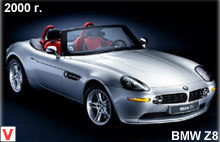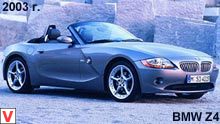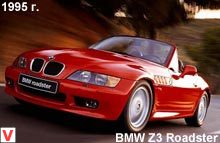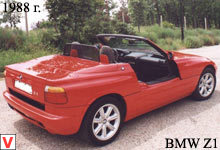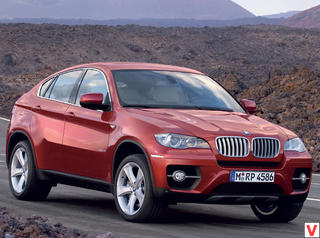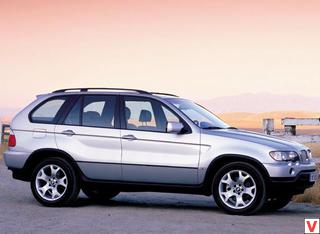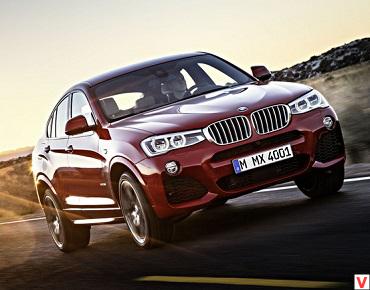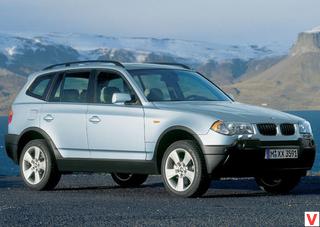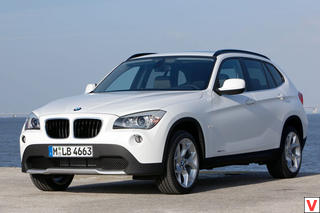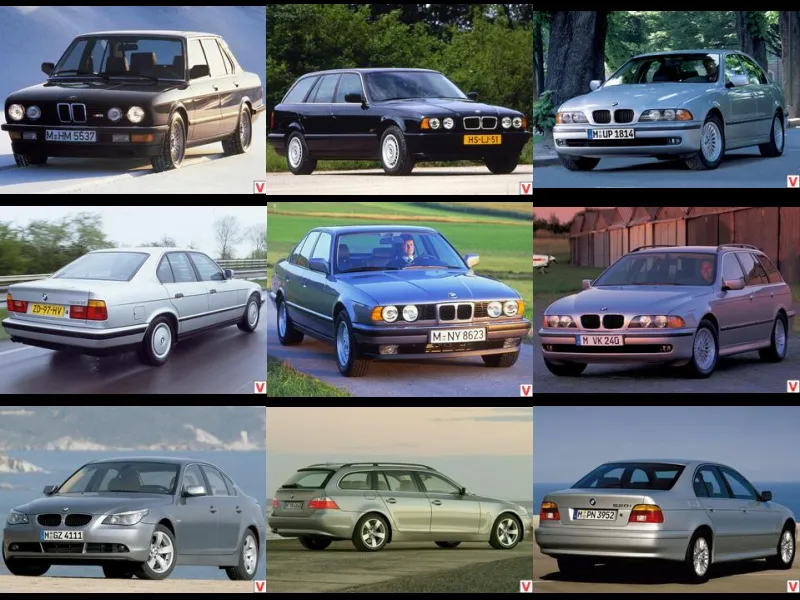
The first generation of the famous 5th series of the Bavarian concern (factory body index E12) debuted in September 1972. Sedan middle class classic layout with distinctive nostrils radiator lining differed a large margin of safety and reliability. Cars were first equipped with only four-cylinder M10 engines with a displacement of 2.0 liters and 115 hp. with a carburetor and 130 hp with a mechanical fuel injection system kugelfischer, the highlight of which was that it used a high-pressure fuel pump (fuel pump), as in a diesel engine. These were models 520 and 520i. A year later, the 525 model was added with a 2.5-liter six-cylinder engine (MLO) of 145 hp.
with a slightly more convex shape of the hood. From June 1974, the economical model 518 with an M10 engine with a displacement of 1.8 liters and a power of 90 hp went (it was sequentially modernized in 1975 and 1980). In July 1976, the 5th model was upgraded for the first time: more than 40 parts in design and design changed, including branded nostrils shifted higher, the hood acquired a characteristic punching, as if pulled over the nostrils, in the roof - a hatch that could lift in the back. Larger tail lights and a new steering wheel.
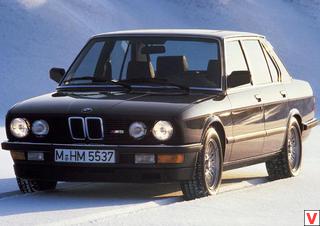
As well as a modern round air filter with a replaceable element and ventilation of the gas tank, the neck of which was transferred to the right wing. The most powerful model 528 with a 2.7-liter six-cylinder carburetor engine MLO with 170 hp. Equipped with ventilated disc brakes. Increased engine power: “520th” - up to 115 hp, “525th” - up to 150 hp, and a year later, a new 6-cylinder carburetor power unit M20 with a capacity of 122 liters was installed on the model 520 .from.
with a camshaft drive toothed belt, the model 528 received the L-Jetronic injection system, which allowed it to increase power to 177 hp, in addition, changed the location of the rear-view mirror (it was transferred to the front triangle of the driver's door window). In 1978, a wear indicator for the front brake pads and a new stalk switch appeared on all models. In July 1981, the 5th series was deeply modernized (new index). The structure of the body was noticeably changed - it became more dynamic, the trim became less chrome, the internal round headlights were reduced, and the rear lights, on the contrary, increased. Therefore, this model is called transitional in both Russia and Germany.

The bumpers used a different design (later, on the M5 high-speed models, designs of the integral type appeared with developed spoilers and painted in the body color). The total mass, depending on the model and additional equipment, decreased by 60-90 kg. The interior of the cabin was reworked even more thoroughly - for the first time the famous instrument panel deployed to the driver appeared with a tight layout of all controls, which looks almost modern and after two decades. Seats of anatomical shape acquired characteristic German stiffness and excellent lateral support. To improve passive safety fuel tank positioned in front of the rear axle.
Significantly improved handling, using a similar 7-series (E23) design of a double-hinged front axle with inclined front shock absorber racks with a small positive shoulder running. A new generation of double-row front wheel bearings has reduced maintenance. The reliability of the brakes is increased due to the larger diameter and floating design of the calipers. At the high-speed (215 km / h) model 528i, an additional braking force regulator and a system for monitoring the level of all technical fluids, as well as the famous system for determining the period of maintenance, were installed.
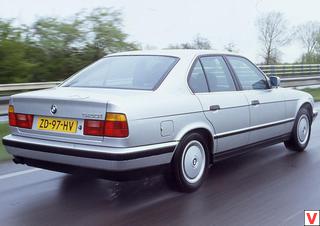
The engines were equipped with improved ignition and fuel injection systems, which all 6-cylinder engines (M20 / 30) began to equip, and the 2.0-liter M20 began to develop 125 hp. In March 1983, a 6-cylinder M20 engine with a displacement of 2.7 liters and 129 hp was installed on the model 525e for the North American market (it was distinguished by more developed bumpers). with the injection system Motronic, and a year later it was equipped with a catalytic converter.
Then, in 1984, another wave of engine upgrades followed: for example, the 1.8-liter M10 engine was equipped with LE-Jetronic injection, due to which the power of the 518i model increased to 105 hp; A new 3.5-liter engine MLO 218 hp, which in the version with a catalytic converter developed only 185 hp. (due to the reduced compression ratio), and in the forced model for the sports model M5 - up to 286 hp at 6500 1 / min and 340 Nm at 4500 rpm, which at that time was one of the highest results for engines of ordinary passenger cars. The maximum speed reached 245 km / h.
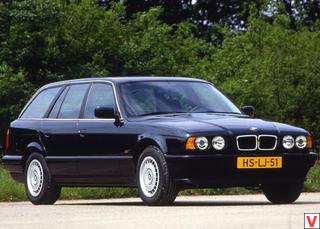
Back in September 1983, the low-cost model 524td made its debut (9.0 l / 100 km) with an MLO turbodiesel with 115 hp capacity, which two years later added a less expensive but more reliable 86-horsepower atmospheric diesel on the 524o. BMW 5th series of this generation is one of the most popular imported cars in the domestic market due to their durability, engine reliability, comfortable cabin (after 1981), good dynamic qualities and design knowledge by the majority of small auto repair shops throughout the country. Fastening the front wings and other elements of the front of the body to the bolts greatly facilitates the repair.
An important factor is the developed market of spare parts, because the price of many of them could quite recently compare with the cost of similar spare parts for domestic models. In January 1988, the E28 was replaced by the 3rd generation of the 5 Series E34, which had a completely new design, but retained the traditional features of the rear-wheel drive four-door BMW five-seater sedans. Cars of the new generation have become a milestone in the history of the company from Munich. The case is not even in appearance (wheelbase 2760 mm; length 4720, width 1750, height 1410 mm; front track 1465, rear - 1485 mm).
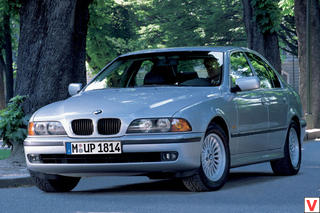
Excellent build quality, finish, ride comfort thanks to the excellent tuning of the chassis, exemplary heating and ventilation systems, immaculate performance of the cabin, high dynamic performance, stable straight run, effective brakes, a high level of active and passive safety - all speaks of the high level of designers who put BMW in the number of world leaders. Sedans of the 5th series (body E34) in terms of build quality and comfort can be put on a par with the luxurious BMW 7th series, somewhat similarly above the products of the eternal rival from Stuttgart - the Mercedes-Benz concern.
The spacious interior is more oriented for the driver's convenience: a black panel with a heavy design, glowing in the dark with orange lighting, is turned in his direction, five driver's seat electrics, a spacious fit in the front seats, as well as excellent ergonomics of controls - all the levers needed for the driver and levers are located where you expect, and the steering wheel as in shape, and, if possible, adjusting the angle of inclination itself asks in hand. Excellent visibility is limited only to the rear - when parking you need to be careful. Moderately soft and silent suspension does not cause discomfort in passengers with any quality of the road.
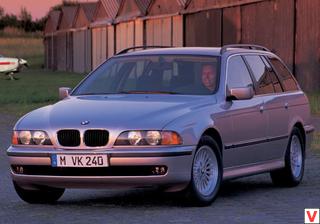
Noiselessness while driving is a proprietary feature of BMW cars. Silent, even with intensive use, trim (except that the leather seats slightly creaks), the engine sounds muffled, even at high speeds. The luggage compartment with a volume of 460 liters, in the lid of which a very complete set of tools is neatly placed, - for many in those years, such a full standard package was a surprise. But all the other additions (except, of course, the ABS company Bosch and airbags for the driver), the company offers only options.
As regards controllability, this rear-wheel-drive car (due to the complex multi-link rear suspension) behaves almost like a front-wheel drive (i.e., smoothly moves to a larger turning radius), and only when driving sharply at very high speed, an overly active driver can disrupt the rear axle . The all-wheel drive version 525iX (from September 1991) is even more active: it is stable and can not only be skidded, but also sharply slipped on dry asphalt wheels (thanks to the anti-skid system), and especially does not allow the car to sit in a puddle on a country road . Here is a dangerous 80-liter fuel tank (behind the rear axle).
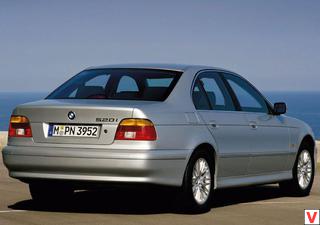
Power steering develops full power when maneuvering, and with increasing speed reduces its action to improve the accuracy of feedback. The "fifth" series became the most representative in the set of engines in the production program of the company, which created for it a wide range of high-quality in-line six-cylinder petrol power units: 2,0 l, 129 hp, tires 195/65 HR15 (model 520i) - frankly rather weak, but economical option (if you do not unscrew the motor); 2.5 liters, 170 hp (525i); 3.0 l, 188 hp, 205/65 VR15 (530i) tires and 3,4 l, 211 hp tires, 205/65 VR15 tires (535i). They were aggregated with automatic 4-band and 5-speed manual gearboxes.
In March 1988, there were economical (9.3 l / 100 km in the city) sedans 524td with a 115 hp turbodiesel. Top model of the sedan M5 with a 3.5 liter engine (315 hp). ) and the fuel tank increased to 90 liters appeared in January 1989 and immediately gained popularity in the circles of amateurs "to ride with the wind." Equipped with a mechanical five-speed transmission, traction control system and 235/45 ZR17 front tires and 255/40 ZR17 rear tires, it became the most dynamic in its class (acceleration to hundreds in 6.3 s, the maximum speed the company limited to 250 km / h).
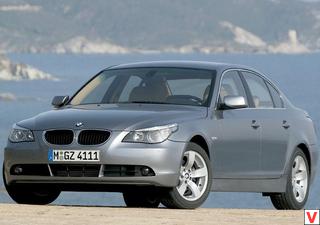
In April 1992, this engine was replaced by a more powerful 3.8-liter 327-strong, and a month later its 340-strong version M5 appeared. Emki have a great appetite for urban traffic (up to 18 l / 100 km), and when buying it is recommended to carefully check the condition and wear of complex adjustable rigid suspension and forced engines. As standard, all cars equipped with brake boosters.
In November 1991, cheap 518i sedans with a high-powered 115-horsepower engine (although not very outstanding dynamics) appeared in the car dealerships, intended mainly for the Eastern European market. And since January 1992, sales of the elegant Touring 520i and 525i station wagons, which, however, did not differ in decent roominess, were in full swing, but they retained all the best rideable qualities of sedans, as well as versions with BMW 525ix Touring all-wheel drive. The luggage compartment with five riders was 460 liters, and with two - 1450 liters, which was not a high indicator (slightly more than in the VAZ-2104).
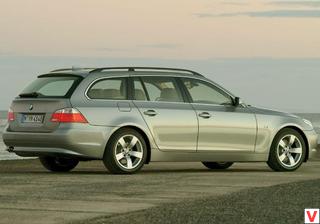
For real off-road this car is not suitable, but here it is quite suitable as a mountain and winter vehicle. Since October 1992, 530i sedans and wagons (218 hp) and 286-horsepower 540i (instead of 535i) equipped with low-noise high-tech V8 engines, as well as the M5 Touring, went on sale. In January 1993, the 115-strong 2.4-liter turbodiesel (524td) was replaced by a 2.5-liter 143-strong turbo diesel with direct fuel injection (525td), which is aggregated with automatic and mechanical gearboxes. In November 1995, the production of all versions of the BMW 5-Series (E34) was curtailed, as the replacement for the model of the newest generation E39.
The debut of the fourth generation of BMW 5-series EZ9 cars took place in September 1995 at the Frankfurt Motor Show. Aggressive, assertive style 5-ki deserved a lot of good reviews on both sides of the Atlantic Ocean. Headlights, hidden under the narrow fairings, elegant rear with a powerful stand and, of course, branded "nostrils" false radiator grille talk about the character of the car. The body was slightly larger - 55 mm in length, 23 in height and 49 in width, which, together with an increase in wheelbase of 70 mm, provided him with shorter overhangs. Plus, the body has significantly increased its rigidity, this not only increased safety, but also improved handling.
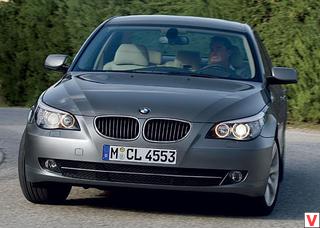
Nevertheless, he did not become harder, although he remained steel. Aluminum is widely embedded in the suspension design. Guiding levers, tie rods, stamped subframes of the front and rear suspensions, suspension strut supports are made of it. Besides, The outer tubes of shock absorbers, brake calipers and, of course, wheel rims have undergone aluminization. Undressed suspension weight decreased by 36% and, as a result, improved performance and comfort. The use of aluminum allows not only to reduce the weight of the car by about a third, but also to reuse the materials of the used car.
The design of the rear suspension, with the "thruster" action of the rear wheels, brings to perfection the excellent behavior of the car on the road. The car is designed in traditional style. The driver's seat is a model of ergonomics. Comfort passengers in the back seat contributes to an increase in the wheelbase of 70 mm. Since the spring of 1997, the Touring has expanded its production program, which is 90 mm longer and 100 kg heavier than the sedan. It has good capacity and maintains the sedan’s excellent rideable qualities.
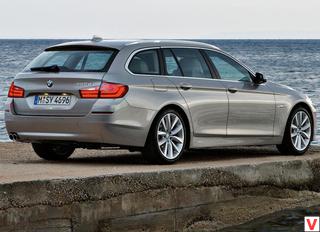
The range of engines for the station wagon is similar to that of a sedan. The list of standard equipment was supplemented by two side airbags. When creating a cargo-passenger version of the car, perhaps more attention was paid to preserving the dynamic characteristics and personality of the exterior. 5-ka Touring - one of the few examples of European station wagons, where the trunk does not look "appendage", but is a harmonious part of the car. The pursuit of style has somewhat worsened the parameters of the luggage compartment - its volume is only 410 liters against 600 liters from a competitor, an E-class Mercedes.
The car comes with both manual and automatic transmission. The BMW 540i Touring is considered to be the fastest production wagon on the planet. At the end of 1997, an armored class B4 model 540i Protection appeared. It is able to withstand small arms (caliber up to 0.44) and grenade explosions. All this was made possible thanks to the armor of aramid and built-in bullet-proof glass. In general, in 1998, at least 500 were produced (the exact figure is kept secret) of such cars at a price of 178400 DM.
A year later, in September 1998, the production of the speed model M5 was resumed. The boosted 5-liter V8 engine, structurally similar to the serial 4.4-liter unit, is equipped with a Double-VANOS system and eight individual throttle valves. For the first time on the BMW production model, engine power reached 400 hp, and the dynamic qualities were even better than that of the M3 - 5.3 with up to 100 km / h M5 is equipped with only 6-speed Manual transmission.
In 1999, the cars didn’t change, but big changes took place under the hood: 6-cylinder engines managed to control both camshafts with the Double-VANOS system, 8-cylinder - with the VANOS system for intake valves and two-stage catalytic converters of exhaust gases, which met Euro 4 requirements 2005 In addition to reducing exhaust emissions, an increase in torque has been achieved and fuel efficiency has increased. Another new product is a 184-horsepower diesel engine with an unseparated combustion chamber, CommonRail injection system, turbocharging and intermediate air cooling on the 530d model. The car can reach 225 km / h and use less than 6 l / 100 km in a standard country cycle.
Despite the complete superiority of the new diesel, the production of the old vortex-chamber (525tds) continued for some time. At the beginning of 2000, an inexpensive 520d appeared with a 2-liter 4-cylinder direct injection diesel engine, first tested on the “three” 320d. Its power (136 hp) is enough to even accelerate the 1.6-ton 5-ku Touring from zero to 100 km / h in 10.9 s. Compared to the gasoline 520i Touring, the average fuel consumption of the new product is reduced by about a third. The more powerful 525d replaced the predecessor 525tds with a swirl-chamber 143-horsepower diesel engine.
The new 2.5-liter 6-cylinder turbocharged direct-injection diesel engine is equipped with a Common Rail fuel injection system and develops 163 hp. Serial configurations include a whole bunch of active safety systems: anti-lock braking system, ASC + T (automatic stability control with traction control), DSC III (dynamic motion stabilization system) and DBC (dynamic stabilization of brake force distribution).
On request, such “options” are possible, such as pneumatic supports for the rear suspension, full “electric package” with memory for installing the driver's seat, steering wheel and rear-view mirrors, double side windows, tire pressure monitoring system (RDC), heated steering wheel, automatic air conditioner with external air pollution control (AUC), etc. In 2000, the driver’s seat of the so-called active type appeared, which had previously been offered only on vehicles of the 7th series. In the fall of 2000, the first modernization of the 5th series models took place.
The externally updated “five” is easily recognized by the transparent block-pharams round yellow turn indicators and a new front spoiler with round fog lights. However, the main changes are hidden inside - here appeared three new M54 engines for models 520i, 525i and 530i. All of them are in-line, 6-cylinder, with Double-VANOS systems and with variable lift intake valves. The first engine for the 520i, created on the basis of the old 2-liter unit. An increase in the piston stroke from 66 to 72 mm made it possible to increase the working volume from 1991 to 2171 cm3 and a maximum power from 150 to 170 hp.
at 6250 rpm The second engine is the former 2.5-liter unit of the 523i, but in a modernized version it develops not only 170, but 192 hp. (523i index was replaced with the correct 525i). In 2003, the long-awaited changes occurred in the 5th BMW series, the BMW E39 changed the new model of the BMW E60 at its post. The car was presented in two body styles: a sedan first appeared, and the following year the model was supplemented with a versatile version.
In the "five", as in the seventh series BMW, they decided to assign a separate label to each body, so the sedan was given the name BMW E60, and the wagon was renamed BMW E61. Designed by Chris Bangle and Adrian van Hooydonk. The exterior of the 5 series has received sharp, expressive lines and dynamic forms. Externally, the new model resembles its predecessor very remotely: a rounded front, a bonnet cut from the sides, and narrow headlights approaching the sides. Inside each headlamp there are two round elements: one with a built-in xenon searchlight (it will turn after the front wheels for a fee, helping to better illuminate the turns), the second - with the usual “halogen”.
Both are surrounded by rims, which are beautifully glowing in the dark, as well as on the post-styling previous “five”. And in the very corners of the headlights five orange LEDs are mounted - these are side “dimensions”. On the rear bumper strip reflectors, reflectors. Another feature of the new car - it looks more compact than the previous "five", although in fact it is larger and more capacious. The wheelbase has increased by 58 mm, overall length - by 66 mm. The car has become much more comfortable and spacious.
A characteristic minus of previous generations - lack of legroom and knees for rear passengers, is a thing of the past. Thanks to the increased wheelbase, the rear passengers will be very comfortable on the E60 model. The volume of the boot is increased by 60 liters. In addition, now the "five" can be equipped with a folding rear seat back and a ski hatch.
Interior geometric and angular. Wide "chamfer" on the panel, energetic vertical strokes of the door handles, covered with wooden veneer, flowing at each other "instrument" and "screen" visors. The three-spoke steering wheel is surprising - it seems too sporty for a business class car, but the rim is thinner than on the previous “five”. Orange lighting devices with clearly defined "aluminum" rims in the dark looks spectacularly cool. For a fee for the testimony of the speedometer can be monitored, almost without taking his eyes off the road - for the new "five" developed a projector of information on the windshield.
Orange numbers, symbols and warning labels seem to hover in the air above the hood. And they do not interfere at all to follow the road situation, but they are perfectly visible to the driver - and only to him alone, because the image simply disappears from a different angle. The armchairs of expensive versions have comfortable headrests, variable side support and a pillow with a built-in massager. On the tunnel between the seats is a large ribbed handle iDrive.
The direction of movement of the controller is only four - instead of eight at the "seven". A large Menu key appeared next to the controller - a function to return to the previous “window”. The very screen with a secret. It is made on the so-called transflective technology: its base reflects the incident light and uses it to improve the brightness of the picture. Moreover, the degree of illumination and reflection of incident light is changed by signals from a special sensor of illumination. And the display provides heating - so as not to “slow down” at low temperatures.
Climate control on the "five" now monitors not only the temperature but also the humidity in the cabin. The most expensive of the audio systems is with a LOGIC7 digital processor and eleven speakers. For the rear passengers there are headphone jacks and a “music” remote control. Motors are the strongest and brightest part of all BMW cars. Not surprisingly, for the "five" there are many. Opens the engine line 163-horsepower gasoline engine 2 liters in volume.
The bulk of the engines was borrowed from the E39. For the year 2003, the five also included: 520i (2.2 - 170hp), 525i (2.5 - 192hp), 530i (3.0 - 231hp), 530d (3.0 - 218 hp). ) and at the top was 545i (4.4. - 333l.s.). Engines aggregated with a 6-speed manual or automatic transmission.
In 2005, 2 new engines appeared, both diesel 525d (2.5 l / 177l.s.) and 535d (3.5 l / 272l.s.), the latter with turbocharging. The new “five” has an ideal “driver” axle weight distribution - fifty-fifty. For such a mass distribution, it was necessary to significantly ease the front of the car. And in order to achieve this, Munich took an unprecedented step. The car body was made by new technology.
Its front is made of aluminum and the back is made of steel. The junction points of different metals were not joined by a weld, but by a riveting method, since these metals “are not friendly” with each other. Also for weight reduction, the front and rear suspension are made of aluminum. McPherson front, and "multi-link" behind. "Five" steering can be ordered in several versions. The basic equipment is just a “rake” with variable pitch and with a hydraulic booster, which allows you to rotate the steering wheel at smaller angles when parking, but in the “near-zero” zone it maintains the normal sensitivity of the steering wheel.
The next step is the Servotronic power steering, which, depending on the speed, changes the force on the steering wheel. And the AFS system (a planetary gear with an electric motor) will add here also an active control of the gear ratio (in addition to the variable pitch of the rack teeth). In 2007, the updated BMW E60 was released. In the restyled version, a rather significant part of the car has undergone a cosmetic change. The model received a new front bumper, which gave the car a more aggressive look, small changes were received by the vehicle's optics, both front and rear.
Changed and salon car. The interior of the restyled "five" received new trim materials, as well as a new gearbox control lever. The engines on all models were modified or replaced with new versions. The BMW 5 Series engine family has been expanded to six petrol and four diesel engines - 170 liters. from. for BMW 520i up to 367 liters. from. for the BMW 550i.
Since 2007, all versions of the BMW 5 Series have become standardly equipped with a set of technologies from the BMW EfficientDynamics family. Innovations such as braking energy recovery technology, gearshift indicator, active air damper control, and technology for connecting or disconnecting auxiliary mechanisms, depending on current conditions, provided an unmatched dynamic-efficiency ratio for all models. In 2008, the BMW 535i E60 was released, which received only a sedan, as well as the all-wheel drive version - 535xi, which was also made in the version of the "wagon".
In January 2008, a truly impressive event was celebrated at the BMW plant in the German city of Dingolfing - since 1973, the plant has produced five million BMW 5 series cars. Completely new, which has already become the sixth generation of the 5 series appeared on the market in 2010. This model has received a factory index F10.
The car is produced at the BMW plant in Dingolfing along with the new BMW 7-Series F01 and BMW 5-Series GT. The sedan has grown a bit. Compared with the predecessor of the BMW E60, the length of the new five increased by 58 mm to 4899 mm, width - by 14 mm to 1860 mm, and the height on the contrary - became lower by 18 mm and is 1,464 mm. The wheelbase is 2968 mm. At the heart of the car is the shortened platform of the new BMW 7-Series sedan. The creators of the car, presenting the novelty, gave it four laconic epithets: elegant, safe, dynamic and successful. By the BMW 5-series 2010 again returned strict, classic for the brand line. The model was designed by Adrian van Hoydonk.
Power units are offered seven: four petrol and three turbodiesel. The top version of the BMW 550i with a 4.4-liter biturbo V8 rated at 407 hp and a maximum torque of 600 Nm. The remaining six-cylinder gasoline engines, with in-line arrangement. Turbocharged unit capacity of 306 hp in version 535i, as well as two atmospheric engines with a power of 258 hp for BMW 528i and 204 hp for BMW 523i. Diesel versions: 530d and 525d with 245 and 204 hp six-cylinder engines.
respectively. The only four-cylinder power unit on the BMW 520d with 184 hp closes the line. This is the most economical engine, it consumes 5.2 liters of fuel for every 100 km of run. The gearbox is a new eight-speed ZF automatic, but the 6-speed manual gearbox is also available.
The model can be equipped with an optional Dynamic Driving Control system, which gives the driver the ability to customize the suspension according to his personal preferences. In addition, the new sedan can be equipped with integral active steering BMW, as well as Adaptive Drive, which includes a system of dynamic adjustment of the stiffness of shock absorbers and a system of dynamic stability control. Driver assistance systems in the new BMW 5 include an automatic parking assistance system, all-round viewing system, a rebuild assistance system, a marking tracking system, a projection display, a BMW night-vision system with pedestrian recognition and a rear-view camera.
In May 2013, the BMW 5-series lineup underwent planned restyling. In addition to the modernized appearance, the family received some changes in equipment and new engines. Modernization of the model did not affect the overall dimensions at all.
Regardless of the performance of the body, the car retained the same dorestayling sizes. In addition, remained the same and ground clearance. The restyled BMW 5-Series 2014 model year can be distinguished from the dorestaylingovoy car by the presence of repeaters of turn indicators in the rear-view mirrors, another front bumper with round foglights and a chrome curved insert, a grille with a reduced number of ribs and a retouched rear bumper.
In addition, the car got new options for the design of wheels, additional options for painting the body, xenon optics in all trim levels (optional access is fully LED), and in addition to the M package, the Luxury Line and Modern Line packages are now available. The interior in the process of facelifting has not changed. The interior updated color schemes. Storage pockets and cup holders have become larger, and as an option, a 10.25-inch TFT display can perform the dashboard function. Depending on the mode of operation of the electronics, the instrument cluster may vary.
For example, when activating a sport mode, the normal speedometer changes to digital, and the selected gear is shown inside the tachometer. The iDrive system received a new version of firmware 4.2. For an additional fee, the buyer of the updated “five” will receive the iDrive multimedia system control joystick, the surface of which will be sensory. With this option, the driver will be able to enter the desired address into the navigator, writing out letters on the surface alternately.
The trunk volume of the updated sedan is 520 liters, the station wagon - 560 liters. Moreover, in the latter case, the usable space can be increased to 1,670 liters thanks to the rear sofa folding in the ratio of 40:20:40. Also, the back seats of the second row can be adjusted by the angle of inclination, and the window of the rear door of the station wagon now opens separately. Also for the station wagon became available system that allows you to open or close the tailgate, just by running his foot under the rear bumper. As for the engines, all of them are now optimized for compliance with Euro-6 environmental standards. Motor range includes four petrol and six diesel engines.
The lineup has a new two-liter turbodiesel, with which the family also receives a new basic modification of the BMW 518d. Motor develops 143 hp and in the combined cycle consumes from 4.5 to 4.9 liters per 100 kilometers, and this engine is installed on both the sedan and the station wagon. The line of diesel engines "five" will also include a pair of "fours" with a capacity of 184 and 218 horsepower and three six-cylinder engines. For the 530d version, a 258-strong unit was prepared, for the 535d - 313-strong, and for the M550d - 381-strong. The last engine allows the sedan to dial the first "hundred" in 4.7 seconds after the start, the station wagon - in 4.9 seconds.
Updated Bavarians and top engine. Now the most powerful in the family 4.4-liter V8 develops 450 hp in the version 550i, and on the M5 sportsede, its output using optional packages can be increased to 575 hp BMW states that the update has affected not only these engines - the rest of the engines have become more economical. Buyers also available in-line "six" power of 306 horsepower. This motor is installed on the modification with the index 535i. The weakest gasoline engines were four-cylinder units of versions 528i and 520i. In the first case, the return is 245 horsepower, in the second - 184 power.
The standard equipment version 520i, 528i, 535i, 518d, 520d and 525d equipped with a six-speed manual transmission. For a surcharge, it can be replaced by an eight-band “automatic”, which is included in the list of basic equipment 550i, 530d, 535d, M550d. The basic equipment already has power steering Servotronic, BMW Professional anti-theft system with satellite communications, bi-xenon headlights, front and rear parking sensors, multifunctional heated steering wheel, heated front seats with electric drive, dual-zone climate control, BMW Professional audio system, on-board computer, dynamic cruise control as well as rain and light sensors. As for the list of additional features, it is big.
As an option for the "five" is available all-wheel drive, Dynamic Damper Control, which automatically changes the stiffness of shock absorbers, depending on the quality of the road surface and driving style, as well as a full-control chassis and lowered M-suspension. The most interesting option is a fully automatic parking assistant. Thanks to electronics, the parking assistant controls not only the steering, but also the gas and brake pedals.
